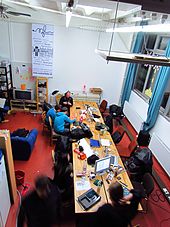
A hackerspace (also referred to as a hacklab, hackspace, or makerspace) is a community-operated, often "not for profit" (501(c)(3) in the United States), workspace where people with common interests, such as computers, machining, technology, science, digital art, or electronic art, can meet, socialize, and collaborate. Hackerspaces are comparable to other community-operated spaces with similar aims and mechanisms such as Fab Lab, men's sheds, and commercial "for-profit" companies.
History
In 2006 Paul Böhm came up with a fundraising strategy based on the Street Performer Protocol to build Metalab in Vienna, Austria, and became its founding director. In 2007 he and others started Hackerspaces.org, a wiki-based website that maintains a list of many hackerspaces and documents patterns on how to start and run them. As of September 2015, the community list included 1967 hackerspaces with 1199 active sites and 354 planned sites.
The advent of crowdfunding and Kickstarter (founded in 2009) has put the tools required to build hackerspaces within reach of an even wider audience. For example, Bilal Ghalib (who had previously worked on a hackerspace documentary) and others used such tools to bring the hackerspace concept to the Middle East.
Worldwide, a large number of hackerspace or makerspace facilities have been founded. Nicole Lou and Katie Peek reported that from 2006 to 2016 the number of active or planned spaces increased to 1,393, fourteen times as many as in 2006.
The US federal government has started adopting the concept of fully open makerspaces within its agencies as of 2015, the first of which (SpaceShop Rapid Prototyping Lab) resides at NASA Ames Research Center.
Activities
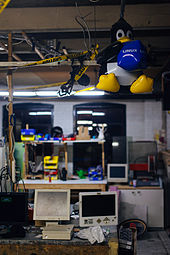
In general, hackerspaces function as centers for peer learning and knowledge sharing, in the form of workshops, presentations, and lectures. They usually also offer social activities for their members, such as game nights and parties. Hackerspaces can be viewed as open community labs incorporating elements of machine shops, workshops, and/or studios where hackers can come together to share resources and knowledge to build and make things.
Many hackerspaces participate in the use and development of free software, open hardware, and alternative media. They are often physically located in infoshops, social centers, adult education centers, public schools, public libraries, or on university campuses, but may relocate to industrial or warehouse space when they need more room.

Most recent studies of hackerspace in China—where Internet access is heavily censored—suggest that new businesses and organized tech conferences there serve to intervene in the status quo "from within". The first hackerspace in China, Xinchejian, opened in Shanghai in 2010. Thereafter a network of hackerspaces emerged, nourishing an emerging maker culture. By designing open technologies and developing new businesses, Chinese makers make use of the system, make fun of it, altering it and provoking it. DIY makers often bring and align contradictory ideas together, such as copycat and open source, manufacturing and DIY, individual empowerment and collective change. In doing so, they craft a subject position beyond the common rhetoric that Chinese citizens lack creativity. As a site of individual empowerment, hackerspace and DIY making enable people to remake the very societal norms and material infrastructures that undergird their work and livelihood.
Facilities
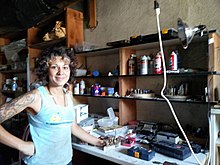
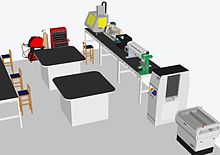
The specific tools and resources available at hackerspaces vary from place to place. They typically provide space for members to work on their individual projects, or to collaborate on group projects with other members. Hackerspaces may also operate computer tool lending libraries, or physical tool lending libraries, up to and including creative sex toys in some instances.
The building or facility the hackerspace occupies provides the physical infrastructure that members need to complete their projects. In addition, most hackerspaces provide electrical power, computer servers, and networking with Internet connectivity. Well-equipped hackerspaces may provide machine tools, sewing, crafting, art fabrication, audio equipment, video projectors, game consoles, electronic instrumentation (such as oscilloscopes and signal generators), electronic components and raw materials for hacking, and various other tools for electronics fabrication and creating things. Specialized large-format printers, 3D printers, laser cutters, industrial sewing machines, CNC machine, or water jet cutters may be available for members to use. Some hackerspaces provide food storage and food preparation equipment, and may teach courses in basic or advanced cooking.
Organization
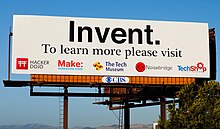
The individual character of a hackerspace is determined by its members. There is a lot of variety in how hackerspaces are organised.
- Some hackerspaces are governed by elected boards selected by active members in good standing. Elected officers may serve predetermined terms, and help direct decision-making with regards to purchasing new equipment, recruiting new members, formulating policy, conforming to safety requirements, and other administrative issues. London Hackspace, for example, is governed by an elected board of trustees.
- Others, such as Open Garage, are led by a single Benevolent Dictator For Life (BDFL). This is a common governance structure for hackerspaces which are founded by a single person on their own property.
- There are also more anarchist governance models such as a Do-ocracy, in which people receive the authority over a task by doing it. This model is often combined with other structures such as elected boards or consensus-driven meetings, as is the case in Noisebridge.
Membership fees are usually the main income of a hackerspace, but some also accept external sponsors. Some hackerspaces in the US have 501(c)3 status (or the equivalent in their jurisdiction), while others have chosen to forgo tax exempt status. University-affiliated hackerspaces often do not charge an explicit fee, but are generally limited to students, staff, or alumni, although visiting guests from other hackerspaces are usually welcome. Some hackerspaces accept volunteer labor in lieu of membership fees, especially from financially limited participants. In addition, some hackerspaces earn income from sponsoring and staffing high-tech flea markets, where members of the general public may buy and sell new and used equipment and supplies.
There is a loose, informal tradition at many hackerspaces of welcoming visitors from other similar organizations, whether across town or internationally. Free exchange of ideas, skills, and knowledge are encouraged, especially at periodic gatherings sometimes called "build nights", "open door" or "open house" days.
Makerspaces are increasingly being included as learning spaces in schools, learning commons, and other educational facilities.
Ethic
Hackerspaces are widely defined on hackerspaces.org as “community-operated physical places, where people can meet and work on their projects”. The exact functioning of the space varies from place to place and is determined by its members and while there is no blueprint or set of guidelines to create a hackerspace, they generally follow a “hacker ethic”, which “include freedom, in the sense of autonomy as well as of free access and circulation of information; distrust of authority, that is, opposing the traditional, industrial top-down style of organization; embracing the concept of learning by doing and peer-to-peer learning processes as opposed to formal modes of learning; sharing, solidarity and cooperation”.
Hackerspaces have also been described as physical manifestations of the peer production principles.
Equity and justice-centered making
Large opportunity gaps in science and engineering (STEM) persist for youth growing up in poverty, and in particular for African American and Latino youth, and have become a focus of STEM-rich Making. The evolving maker movement has generated interest for its potential role in opening up access to learning and attainment in STEM, with advocates arguing for its “democratizing effects" – with access to a makerspace, “anyone can make... anyone can change the world”. Makerspaces potentially offer opportunities for young people to engage in STEM knowledge and practices in creative and playful ways, where “learning is and for the making”.
However, an explicit equity-agenda has been fairly absent in the maker movement, especially as it relates to sustained engagement in making. The movement remains an adult, white, middle-class pursuit, led by those with the leisure time, technical knowledge, experience, and resources to make. Even with the growth of community-based makerspaces, users of these spaces tend to be white adult men. The median salary for those involved in the maker movement in the US is $103,000, with 97% of those who go to Maker Faires having college degrees (and 70% have graduate degrees). Only 11% of the contributions to Make Magazine (the periodical credited with launching the Maker Movement) are female. Thus, as the maker movement has become formalized, the powerful knowledge and practices of communities of color or of low-income communities have not yet become central to its discourse.
Emerging research has begun to address how the maker movement might address equity concerns broadly. There is recent research in this area, which is challenging the field to consider new directions in the design of maker spaces, in maker space programming and pedagogies, and in how to make sense of the outcomes of making. These include: 1) Expanding what counts as making; 2) Design of makerspaces that foster an open, flexible and welcoming atmosphere to youth; 3) Maker space programs and pedagogies that support an equitable culture of making, the incorporation of participants’ cultural knowledge and practices, a focus on new literacies; and valuing multiple iterations and failing-forward; and 4) Expanding the outcomes of making to include agency, identity, and the after-life of maker projects. Cutting across these areas are specific attention to gender and computer science, indigenous epistemologies and maker activities, and how makerspaces may ground STEM-rich making in the lived experiences and wisdom of youth of color and their families and communities.
One emerging area of studies examines the production of an equitable culture in making, including in-depth longitudinal cases of youth makers in community settings, how youth and community co-design for equitable learning opportunities and outcomes.
Difficulties and critique
Hackerspaces can run into difficulties with building codes or other planning regulations, which may not be designed to handle their scope of activities. For example, a new hackerspace in Nashua, New Hampshire, was shut down by the city after an inspection in 2011. The main issues involved ventilation of heat and toxic fumes; the space was reopened after improvements were made to the building.
The difficulties with opening hackerspaces and makerspaces within non-profit organizations, such as schools and public libraries include cost, space, liability, and availability of personnel. Many makerspaces struggle to sustain viable business models in support of their missions.
Hackerspace culture may have more demonstrable challenges than the spaces themselves. For more, see: Maker Culture#Criticisms.
In 2009, Johannes Grenzfurthner published the much debated pamphlet "Hacking the Spaces", that dealt with exclusionist tendencies in the hackerspaces movement. Grenzfurther extended his critique through lectures at the 2012 and 2014 Hackers on Planet Earth conferences in New York City.
Benefits
- Research suggests that hackerspaces can impact psychosocial skills, such as having motivation, self-directing ones learning, taking initiative, confidence in oneself, and taking risks in a positive manner.
- Experiences in hackerspaces help relate material learned in the classroom to the real world.
- Allows students access to a broader variety of resources and materials they otherwise wouldn't have access to.
- Provides underprivileged students with equal STEM opportunities they otherwise would not be able to receive.
- Promotes hands-on learning which is one of the best learning methods for children.
- Provides students with experience in persistence and using failure as learning opportunities.
- Increases leadership and collaboration skills as most hackerspace experiences require working with others.
Notable hackerspaces
A directory is maintained at the hackerspaces.org wiki. For some other notable examples, see: Category:HackerspacesOver the years, many hackerspaces have grown significantly in membership, operational budgets, and local media attention. Many have also helped establish other hackerspaces in nearby locations.
- c-base (1995) from Berlin is recognized as one of the first independent, stand-alone hackerspaces in the world, not affiliated with a school, university, or company. Wired writes that "European groups, particularly in Germany, have a long tradition of this kind of activity". Another known German hackerspace is RaumZeitLabor, organizer of Trollcon.
- The Geek Group, formed in 1994, was a budding nonprofit hackerspace in Grand Rapids, Michigan that had a large following and internet presence. There were various chapters around the United States. Their main focus was as an opensource hackerspace to increase STEM education accessibility and one day become an accredited institution of higher education.
- Metalab, founded in 2006, is generally considered to have pioneered the funding principles that enabled rapid spread of the concept.
- TechShop was the first chain of commercial hackerspaces. It was launched in October 2006. As of October 2012, there were six TechShop locations in the US: three in California and one each in North Carolina, Michigan, and Texas, the last a partnership with the Lowe's home improvement chain. As of May 2019, the company had declared bankruptcy, with plans for reorganization or liquidation to be announced.
- In August 2007, a group of North American hackers visited Europe "to get a sense for the potential of European 'hacker spaces'", and upon their return, the groups NYC Resistor and HacDC were set up in late 2007, with Noisebridge following in fall 2008.
- RevSpace is a Dutch hackerspace founded in 2009. A regular of its IRC channel perpetrated a DDoS attack on VISA and MasterCard in 2010.
- Dallas Makerspace (DMS) was founded by members of the Dallas Personal Robotics Group (DPRG) in 2010. As of summer of 2017, it has a paying membership base of 1500, "making it one of the largest, if not the largest, nonprofit, volunteer-run makerspaces in the country" according to Dallas Morning News.
- The first Chinese hackerspace Xinchejian was established in Shanghai in the fall of 2010. Thereafter hackerspaces have grown in numerous cities including Beijing, Shenzhen, Ningbo, Hangzhou and Guangzhou. Chinese makers became internationally visible when the first Maker Carnival was hosted in Beijing in 2012.
- Columbus Idea Foundry moved into a 65,000-square-foot factory in Columbus Ohio on May 22, 2014. By one account, it is "the country's largest such space".
- NASA's Ames Research Center Rapid Prototyping Lab was developed as the first open makerspace within the US Federal Government. It has trained thousands of Federal employees on emerging rapid-prototyping equipment.
- Artisan's Asylum (Somerville, Massachusetts), was once believed to be the largest makerspace in the world.
- the Verstehbahnhof in Fürstenberg (Havel) station is an example of a makerspace in a rural German town with a declining population. Daniel Domscheit-Berg is one of the principal contributors to this space.
Variations
A lot of places share values similar to those purported by hackspaces, whether or not they use that nomenclature. A few examples follow:
Public library hackerspaces
Public Libraries have long been a place to share resources for learning. Lately some have reconsidered their roles to include providing resources for hacking and making. Those generally call themselves Library makerspaces. For example, Chattanooga's 4th floor may have been the first use of a library as laboratory and playground for its community. The User Experience (UX) is another public laboratory and educational facility. Or according to Forbes, the first public library to open a MakerSpace is the Fayetteville Free Library.
Feminist hackerspaces
In response to the misogyny allegedly shown by the brogrammer culture that sees hackerspaces as "male" spaces, Seattle Attic was founded in the summer of 2013, as the first Feminist Hackerspace in the United States. They were soon followed by Double Union, in San Francisco. Their founding came as a result of The Ada Initiative, and their AdaCamp conferences. Which has also led to the formation of FouFem in Montreal, the Mz Baltazar's Laboratory, a start-up organization and feminist hackspace in Vienna, the Anarchafeminist Hackerhive in San Francisco, the Hacktory in Philadelphia and the Miss Despionas in Tasmania, Australia, and myriad others.
Public school maker/hackerspaces
Some public schools in the US now also include hackerspaces. The first high school to open a true MakerSpace was in Sebastopol, California, and middle schools followed the trend. For example, White Hill Middle school in Fairfax, California has now opened up their own MakerSpace with a class called "Makers and Hackers". In 2018 Penketh High School became the first school to have a school makerspace in the United Kingdom. "Spark" was designed for students and the community being the first of its kind in the UK.
In Shenzhen, China SteamHead makerspace organized a school makerspace inside Shenzhen American International School in 2014, and SZ DIY makerspace organized a school makerspace inside Harbour School.
Fab labs
Fab labs are spaces (part of a network initiated by MIT's Center for Bits and Atoms) whose goal is to enable people to "make (almost) anything". They focus heavily on digital fabrication tools.
Community spaces
There are many community art spaces share values with hackerspaces. Some, like AS220 and Haystack Mountain School of Crafts have embraced Fab lab structures to expand the range of media represented in their spaces to include digital fabrication tools. There are also community-based makerspaces focused on open-access to allow community members to address community-based problems. For example, to share resources and access to critical manufacturing equipment. Makerspaces could also be seen as spaces for the co-production of convivial tools that “foster conviviality to the extent to which they can be easily used, by anybody, as often or as seldom as desired, for the accomplishment of a purpose chosen by the user”.
From a justice perspective, the open access is important because many makerspaces are pay-to-play. Examples of community-based making spaces include GET City and Mt Elliot, both in Michigan.
University maker/hackerspaces
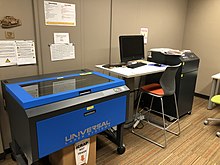
Universities around the world have at different rates embraced educational possibilities of these spaces. Makerspaces provide colleges and universities with an inspirational environment where innovative connections between technology and curriculum can be utilized for experiential teaching and learning activities MIT has pioneered the Fab lab movement and implementation of similar spaces in universities around the world. Non-Fab-Lab-associated Maker and Hackerspaces are also common. Wheaton College is one school pioneering new Hacker and Maker curriculums and spaces, as is Yale University with spaces like its "CEID". Franklin W. Olin College of Engineering has also pioneered Makerist and Hacker curriculum to great success. The Bioengineering Department at the University of Pennsylvania's School of Engineering and Applied Science combines their educational lab space with an open Bio-MakerSpace in their George H. Stephenson Foundation Educational Laboratory & Bio-MakerSpace (or Biomakerspace or BioMaker Space), encouraging a free flow of ideas, creativity, and entrepreneurship between Bioengineering students and students throughout the university. William & Mary is rapidly expanding their makerspace resources to include engineering spaces for all undergraduate & graduate degrees as part of their new Coll curricula.
Tool library
Tool libraries generally lack a shared space for making or hacking things, but instead serve as a repository of tools people can borrow for use in their own respective spaces.
Repair cafe / clinic
"Repair cafés" are semipermanent places where people can come together to teach and learn how to fix things. "Repair clinics" are pop-up events without permanent facilities, though they are often sponsored by organizations such as public libraries, schools, or universities. The emphasis is on basic DIY repairs rather than building new things, but there is a similar informal atmosphere of exploration and learning new skills.
Bicycle coops
Bicycle cooperatives are places where people can build or fix bicycles.
Cooking makerspace
A place where anyone can use different professional kitchen equipment and try culinary experiments.
See also
- Hacker culture – Subculture of individuals
- Hackerspace Global Grid
- Maker culture – Community interested in do-it-yourself technical pursuits
- Maker Faire – Convention of DIY enthusiasts
- Men's shed – Non-profit local organisations that provide a space for craftwork and social interaction
- Tinkering School – school in the United StatesPages displaying wikidata descriptions as a fallback
References
- Alan Henry (23 May 2012). "How To Find And Get Involved With A Hackerspace". lifehacker.com.au. Retrieved 28 May 2015.
- ^ Hackerspaces.org (n.d.). "List of Hacker Spaces". Hackerspaces. Retrieved September 30, 2015.
- Ghalib, Bilal (September 1, 2012). "Baghdad Community Hackerspace Workshops". Kickstarter. Retrieved September 13, 2012.
- "By The Numbers: The Rise Of The Makerspace". Popular Science. Retrieved 2018-09-26.
- Mazhari, Alex (2015-02-26). "NASA Ames SpaceShop". NASA. Archived from the original on 2019-04-02. Retrieved 2019-03-26.
- Saini, Angela (June 19, 2009). "DIY Gadgetry". BBC News.
- "In China, Lessons of a 'Hackerspace'".
- Lindtner, Silvia (2014), "Hackerspaces and the Internet of Things in China: How makers are reinventing industrial production, innovation, and the self", China Information 28(2): 145-167.
- Williams, Wyatt (November 30, 2009). "Freeside Atlanta makes space for local hackers". Creative Loafing. Archived from the original on 2009-12-07. Retrieved 2009-12-01.
- Campbell, Hayley (2017-12-10). "Better loving through technology: a day at the sex-toy hackathon Sound-controlled vibrators, 3D-printed clitorises and 'Michael Gove' as a safe word: coders and inventors try to find the future of sex in south London". The Guardian. Retrieved 2018-02-05.
- Roush, Wade (May 22, 2009). "People Doing Strange Things With Soldering Irons: A Visit to Hackerspace". Xconomy.com.
- "How To Start A Hackerspace: Part 4 – Get It Done". 15 November 2012.
- ^ Kostakis, Vasilis; Niaros, Vasilis; Giotitsas, Christos (September 2015). "Production and governance in hackerspaces: A manifestation of Commons-based peer production in the physical realm?". International Journal of Cultural Studies. 18 (5): 555–573. doi:10.1177/1367877913519310. ISSN 1367-8779. S2CID 43973532.
- "Organisation/Trustees - London Hackspace Wiki". wiki.london.hackspace.org.uk. Retrieved 2019-06-24.
- "Benevolent Dictator - HackerspaceWiki". wiki.hackerspaces.org. Archived from the original on 2019-06-24. Retrieved 2019-06-24.
- Sebrechts, Merlijn; Gent, Hackerspace. The Hackerspace Blueprint: Empowering people to be awesome. Merlijn Sebrechts.
- "About". Pumpinstationone.org. Retrieved 19 February 2010.
- Cameron Guthrie (2014): Empowering the hacker in us: a comparison of fab lab and hackerspace ecosystems. Paper presented in: 5th LAEMOS (Latin American and European Meeting on Organization Studies) Colloquium, Havana Cuba, 2‐5 April 2014
- Kostakis, V.; Niaros, V.; Giotitsas, C. (2014): Production and governance in hackerspaces: A manifestation of Commons-based peer production in the physical realm?. Published in:International Journal of Cultural Studies
- Hatch, M (2014). The maker movement manifesto. McGraw-Hill. p. 10.
- Sheridan, K. M., Halverson, E. R., Brahms, L., Litts, B. K., Jacobs-Priebe, L., & Owens, T. (2014). "Learning in the making: A comparative case study of three makerspaces". Harvard Educational Review. 84 (4): 505–531. doi:10.17763/haer.84.4.brr34733723j648u. S2CID 145488840.
{{cite journal}}: CS1 maint: multiple names: authors list (link) - Vinodrai, Nader, Zavarella (2021). "Manufacturing space for inclusive innovation". Local Economy. 36 (3): 205–223. doi:10.1177/02690942211013532. PMC 8504410. PMID 34650320.
{{cite journal}}: CS1 maint: multiple names: authors list (link) - K. Peppler, E. Halvorsen., & Y. Kafai (2016). Makeology: Makerspaces as Learning Environments. Routledge. pp. 15–29.
{{cite book}}: CS1 maint: multiple names: authors list (link) - Tan, Edna; Angela Calabrese Barton; Schenkel, Kathleen (2018). "Methods and Strategies: Equity and the Maker Movement". Science and Children. 055 (7): 76–81. doi:10.2505/4/sc18_055_07_76. ISSN 0036-8148.
- Tan, Edna; Calabrese Barton, Angela (2018-01-02). "Towards Critical Justice: Exploring Intersectionality in Community-based STEM-rich Making with Youth from Non-dominant Communities" (PDF). Equity & Excellence in Education. 51 (1): 48–61. doi:10.1080/10665684.2018.1439786. ISSN 1066-5684. S2CID 150173739.
- ^ Kafai, Yasmin; Fields, Deborah; Searle, Kristin (December 2014). "Electronic Textiles as Disruptive Designs: Supporting and Challenging Maker Activities in Schools". Harvard Educational Review. 84 (4): 532–556. doi:10.17763/haer.84.4.46m7372370214783. ISSN 0017-8055.
- ^ Angela, Calabrese Barton (27 July 2018). STEM-rich maker learning : designing for equity with youth of color. Tan, Edna. New York, NY. ISBN 9780807759233. OCLC 1028843326.
{{cite book}}: CS1 maint: location missing publisher (link) - ^ Calabrese Barton, Angela; Tan, Edna (August 2018). "A Longitudinal Study of Equity-Oriented STEM-Rich Making Among Youth From Historically Marginalized Communities". American Educational Research Journal. 55 (4): 761–800. doi:10.3102/0002831218758668. ISSN 0002-8312.
- ^ Barajas-López, Filiberto; Bang, Megan (2018-01-02). "Indigenous Making and Sharing: Claywork in an Indigenous STEAM Program". Equity & Excellence in Education. 51 (1): 7–20. doi:10.1080/10665684.2018.1437847. ISSN 1066-5684. S2CID 149539777.
- Tucker-Raymond, Eli; Gravel, Brian E.; Wagh, Aditi; Wilson, Naeem (2016). "Making It Social: Considering the Purpose of Literacy to Support Participation in Making and Engineering". Journal of Adolescent & Adult Literacy. 60 (2): 207–211. doi:10.1002/jaal.583. ISSN 1936-2706.
- Ryoo, J. Bulalacao, N., Kekelis, L., McLeod, E., & Henriquez, B., J (2015). "Tinkering with "failure": Equity, learning, and the iterative design process". Fablearn.
{{cite journal}}: CS1 maint: multiple names: authors list (link) - Barton, Angela Calabrese; Tan, Edna (2017). "Equity-oriented STEM-rich making among youth from historically marginalized communities". Proceedings of the 7th Annual Conference on Creativity and Fabrication in Education. New York, New York, USA: ACM Press. pp. 1–4. doi:10.1145/3141798.3141809. ISBN 9781450363495. S2CID 8269177.
- "MakeIt Labs, the new 'hackerspace' in Nashua, closed by the city for permits, other issues". Nashua Telegraph. Retrieved 28 May 2015.
- Educause. "7 Things You Should Know About Maker Spaces" (PDF). Archived from the original (PDF) on 2013-11-02. Retrieved 31 October 2013.
- "In London, makers face gentrification". Makery. Retrieved 2018-07-17.
- Shivers-McNair, Ann (2021). Beyond the Makerspace: Making and Relational Rhetorics. University of Michigan Press. pp. 1–158. ISBN 978-0-472-90241-5.
- Niarchos, Nicolas. "A Print Magazine for Hackers". The New Yorker. Retrieved 5 February 2019.
- Dunbar-Hester, Christina (2020). Hacking Diversity: The Politics of Inclusion in Open Technology Cultures. Princeton Studies in Culture and Technology. p. 59. ISBN 978-0-691-19288-8.
- ^ Mersand, Shannon (September 2021). "Untapped Potential: Makerspace as Conduit for Talent Development". Journal of Thought. 55 (3/4): 39–58 – via EBSCOhost.
- Barton, Angela Calabrese; Tan, Edna; Greenberg, Day (June 2017). "The Makerspace Movement: Sites of Possibilities for Equitable Opportunities to Engage Underrepresented Youth in STEM". Teachers College Record: The Voice of Scholarship in Education. 119 (6): 1–44. doi:10.1177/016146811711900608. ISSN 0161-4681 – via Sage Journals.
- Woods, Stacey; Hsu, Yu-Chang (May 2020). "Making Spaces for STEM in the School Library". TechTrends. 64 (3): 388–394. doi:10.1007/s11528-019-00460-9. ISSN 8756-3894 – via EBSCOhost.
- ^ Borland, John (August 11, 2007). ""Hacker space" movement sought for U.S." Wired. Retrieved August 7, 2012.
- "Trollcon 2012". Heise.de. 21 October 2012. Retrieved 2013-07-10.
- Brugh, Willow (January 16, 2012). "Metalab, Extroverted Viennese Hackerspace". MAKE. Retrieved October 30, 2018.
- Woods, Dan (15 November 2017). "TechShop Closes Doors, Files Bankruptcy". Make: DIY Projects and Ideas for Makers. Retrieved 2019-05-15.
- Su, Jean Baptiste. "Report: TechShop Shuts Down, Files For Bankruptcy Amid Heavy Losses, Unsustainable Business Model". Forbes. Retrieved 2019-05-15.
- Tweney, Dylan (March 29, 2009). "DIY Freaks Flock to 'Hacker Spaces' Worldwide". Wired. Retrieved August 7, 2012.
- Winter, Brenno de (2010-12-10). "Hackers rally around Dutch WikiLeaks DDoS suspect". Computerworld. Retrieved 2020-01-21.
- ^ Bustillos, Esteban (9 June 2017). "Creators find camaraderie — and lifelong learning — at the Dallas Makerspace". The Dallas Morning News. Retrieved 18 August 2017.
- Lindtner, Silvia (2014), "Hackerspaces and the Internet of Things in China: How makers are reinventing industrial production, innovation, and the self", China Information 28(2): 145-167.
- "Columbus Idea Foundry becomes a work in progress". The Columbus Dispatch. November 2, 2014. Archived from the original on 2015-07-11. Retrieved 2015-06-26.
- Thompson, Derek (23 June 2015). "A World Without Work". theatlantic.com.
- Mazhari, Alex (2017-06-28). "NASA Ames SpaceShop". NASA. Archived from the original on 2019-04-02. Retrieved 2019-03-26.
- Flaherty, Joseph. "Building Stompy the Giant Robot Inside the World's Biggest Hackerspace". Wired.
- "In Somerville and Lowell, do-it-yourselfers making it work - The Boston Globe". bostonglobe.com.
- "4th Floor". chattlibrary.org. Retrieved 28 May 2015.
- "Making Room for Innovation". Library Journal. Retrieved 28 May 2015.
- "First Public Library to Create a Maker Space". Forbes. Retrieved 13 November 2017.
- Toupin, Sophie. "Feminist Hackerspaces: The Synthesis of Feminist and Hacker Cultures". Journal of Peer Production. Retrieved 14 February 2015.
- Henry, Liz. "The Rise of Feminist Hackerspaces and How to Make Your Own". Model View Culture. Retrieved 14 February 2015.
- "Double Union". Retrieved 14 February 2015.
- Toupin, Sophie. "Feminist Hackerspaces as Safer Spaces?". Feminist Journal of Art and Digital Culture. Retrieved 11 April 2015.
- "White Hill Robotics". Retrieved 31 October 2013.
- "Penketh High becomes first state school in the country to build dedicated 'makerspace'". Warrington Guardian. 22 February 2018. Retrieved 2018-04-15.
- "Design and Maker Education for Shenzhen's Children and Young People". V&A. 9 August 2016. Retrieved 3 August 2019.
- Kostakis, Vasilis; Niaros, Vasilis; Giotitsas, Chris (2023-09-01). "Beyond global versus local: illuminating a cosmolocal framework for convivial technology development". Sustainability Science. 18 (5): 2309–2322. doi:10.1007/s11625-023-01378-1. ISSN 1862-4057.
- "Developing Experiential Curricula". Lone Star College. Retrieved 2020-01-31.
- "IMAGINE Network - Wheaton College Massachusetts". Wheaton College Massachusetts. Archived from the original on 2018-01-06. Retrieved 2018-01-05.
- "Making matters - Wheaton College Massachusetts". Wheaton College Massachusetts. Archived from the original on 2018-01-06. Retrieved 2018-01-05.
- "CEID Homepage". Yale CEID. Retrieved 2018-01-05.
- "From Course Instruction to Bio-MakerSpace: Creating a Lab Space for Independent Investigation and Innovation: American Society for Engineering Education". www.asee.org. Retrieved 2019-06-27.
- Brinkman, Camilla (7 February 2012). "Education, empowerment and enlightenment through guided disassembly of your broken stuff". MIT News. Massachusetts Institute of Technology. Retrieved 2019-05-15.
- Marx, Ilona (December 2018). "The high-tech playground". KTCHNrebel. Retrieved 2018-11-08.
External links
- HackerspaceWiki – Global hackerspace database and resource
- Kalish, Jon (November 28, 2010). "A Space For DIY People To Do Their Business". NPR.
| Hackerspace | |||||||||
|---|---|---|---|---|---|---|---|---|---|
| Asia |
| ||||||||
| North America | |||||||||
| Europe |
| ||||||||
| Oceania |
| ||||||||
| Related topics | |||||||||